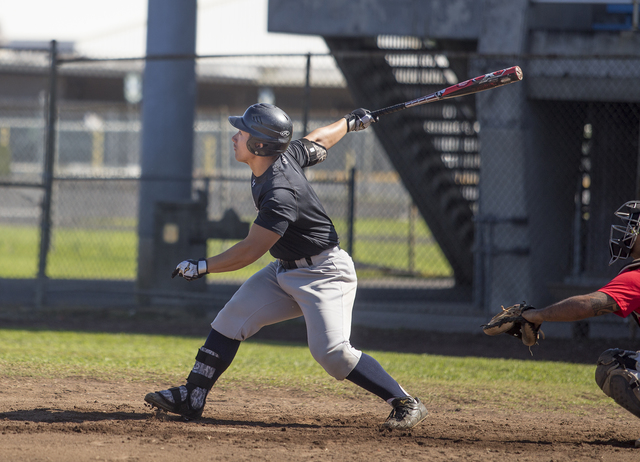Growth in athletic programs can occur in different ways at different places. They still haven’t come up with a handy step-by-step guidebook for coaches who take over troubled teams and need to chart a new, successful course. Everybody gets to
Growth in athletic programs can occur in different ways at different places. They still haven’t come up with a handy step-by-step guidebook for coaches who take over troubled teams and need to chart a new, successful course. Everybody gets to figure it out on their own.
For Kallen Miyataki, uncertainty has become a step in the right direction.
In his first two seasons after replacing Big Island baseball legend Joey Estrella, lineup decisions weren’t a major challenge for the UH-Hilo baseball coach. But after a fall practice session that ended in November and a week of practice to set the 2016 season in motion, you could probably pick names out of a hat and comes as close as Miyataki to predicting the starting lineup next month when the Vulcans open the schedule at UH-Manoa on Feb. 13.
Depth, and especially versatility on the roster brings a smile. Miyataki took a long pause when he was asked who his position players might be when the Vulcans play the first of two games against the Rainbow Warriors.
“Honestly,” he said, a grin breaking out on his face, “your guess would be as good as mine. It’s nice to be able to say that for a change. The lineup is going to take all month to figure out, I can see that already.”
The numbers have increased in quantity as well as quality. There were 45 roster aspirants in fall ball, but after a week, Miyataki has trimmed it down to 36 with literally dozens of possible lineups.
For example, junior Edison Sakata got his introduction last year with 46 starts in the infield and can play multiple positions, senior Michael Jenkerson has the kind of speed you want in a centerfielder, senior catcher Sean Nearhoof provided clutch hits, and the list goes on.
Miyataki isn’t expecting his players can reverse last year’s 11-35 record, but he’s aware there’s experience where there was none last year and the versatility means he has more options.
“Right now,” he said, “it’s fun. You can tell, you can feel, that we’re getting better, but you also understand our situation naturally creates a kind of uphill battle.
“That’s OK, we know who we are.”
It’s never far from the consideration of Vulcan athletics that the school operates on a reduction in the basic structural features common to its Pacific West Conference opponents. The baseball team has the equivalent of about 4.7 baseball scholarships to offer, the only team in the 14 school conference with fewer than the NCAA-allowed maximum of nine.
So, this is how you compete at UH Hilo; you gather four-year players, you hope after a year or two of being in the program they will develop, physically and mentally into the kind of players others schools are better prepared to bring in as freshman. It takes time to build these kind of rosters in order to generate consistency without having a collection of players who all grow into it at once. The trick is to develop a mix of upperclassmen with a new churn ready to move in as juniors.
In that regard, the coach has an ace up his sleeve. Jordan Kurokawa, the 6-foot-3 senior right-handed pitcher is back for a year that could define the growth pattern Miyataki is hoping to develop at UH-Hilo. Kurokawa was named the Golden State Collegiate Baseball League pitcher of the year this summer after a 7-0 record and 2.64 earned run average.
For the Vulcans last year, Kurokawa was 3-4 in 70. 1 innings with a 3.07 ERA and 68 strikeouts for a UH-Hilo team that struggled mightily to score runs. His personal development, though, soared past those issues as he has built his fastball to a level where he throws at 92 mph waking up in the morning.
At a Saturday scrimmage at Wong Field, Kurokawa threw 20-25 pitches in two innings in that range, and then threw about that many more in the bullpen.
“Feels real good,” he said, “it was just a comfortable feeling, we are all ready to get going again.”
Especially Miyataki.
“He’s got to be the guy for us and he knows that,” Miyataki said. “Along the way, we’ve talked about learning more how to pitch, changing speeds, backing off when he can, coming after people when he needs to; we are building around him.”
“I’m ready for that,” Kurokawa said, “I want to help lead this team. We have a good group of guys, some talent, some versatility, everybody is buying in.”
It’s almost a month until it begins again, but it’s a different feeling around this team, according to the coach.
“We can only control our own environment,” Miyataki said, “I’m optimistic about it because our guys seem to get it that the goal is to not try to be someone else, but just to be as good as we can be. If we can do that, we’ll be OK.
“It’s starting to change,” he said, “for the better.”
Email Bart with thoughts or tips at barttribuneherald@gmail.com




